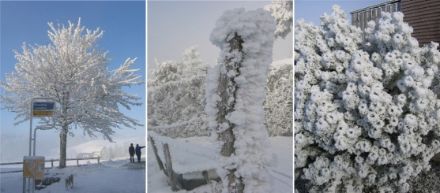Service Navigation
Search
In fog and freezing temperatures, water droplets can adhere to solid surfaces. Either hoar frost or hoar ice forms depending on the location and weather.
Hoar frost
Hoar frost consists of delicate ice needles or ice scales. It usually forms in the areas around the top of low stratus or fog, or where radiation is reflected away at fog margins at temperatures well below freezing. Hoar frost is created by a process called sublimation. In this process, the gaseous water vapour changes directly into a solid state and is deposited on solid objects. For this to happen, temperatures need to be below -8°C, with high humidity and light winds.

Hoar ice
Hoar ice is granular, grey-white ice deposits that adhere firmly to solid surfaces. It occurs in fog and
temperatures between -2°C and -10°C, when mist droplets quickly freeze when they come into contact with solid surfaces. Stronger winds encourage the formation of hoar ice. Hoar ice often forms during inversions when the temperature is lower than in the air layer above (see inversion). Hoar ice grows against the wind direction and can form bizarre structures.

Industrial snow
In urban areas, the moisture present in fog sometimes falls from the sky in the form of snow. This is called industrial snow. The phenomenon can be observed during prolonged inversions near industrial plants that emit large amounts of water vapour, such as waste incineration plants or paper mills. In nuclear power plants with cooling towers, however, the phenomenon does not occur because the emitted steam plume is usually so warm that it penetrates the inversion layer and evaporates in the dry air.
For industrial snow to occur, two conditions must be met: The inversion must be no higher than about 900 m above sea level and the temperature at the bottom of the inversion layer must be at least -5 to -12 degrees. With these ingredients, a few centimetres of snow can fall locally, while above the thick layer of fog on the surrounding hills the sun shines down from a cloudless sky.